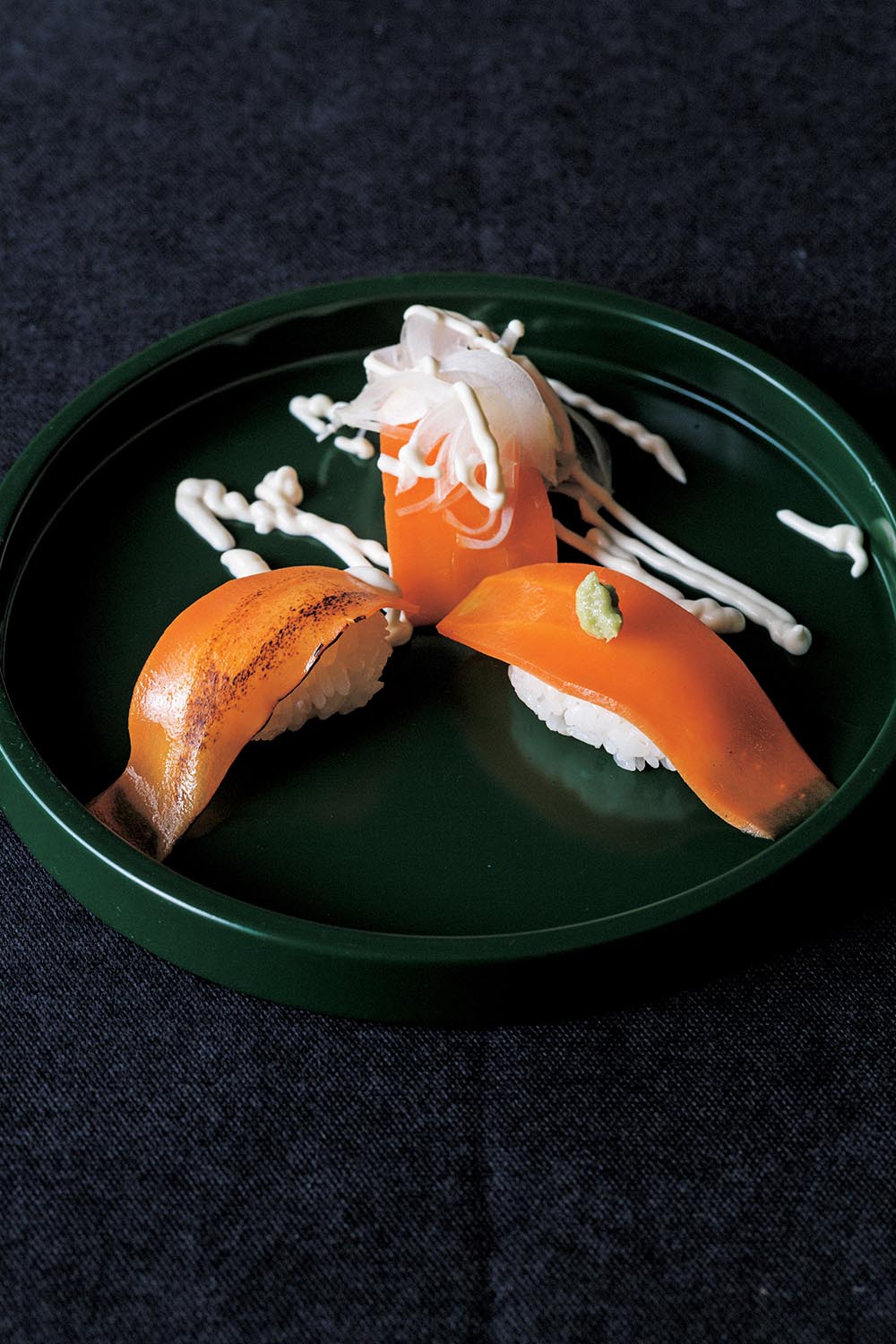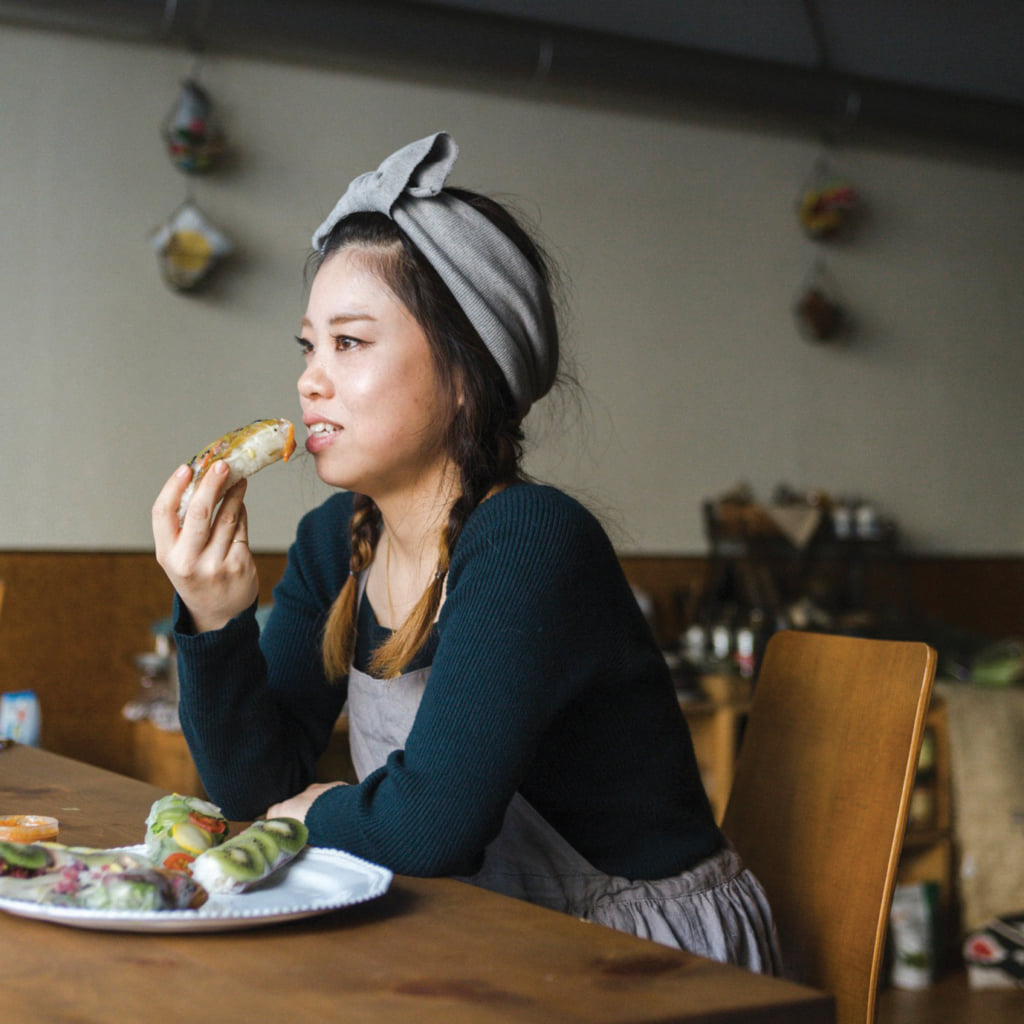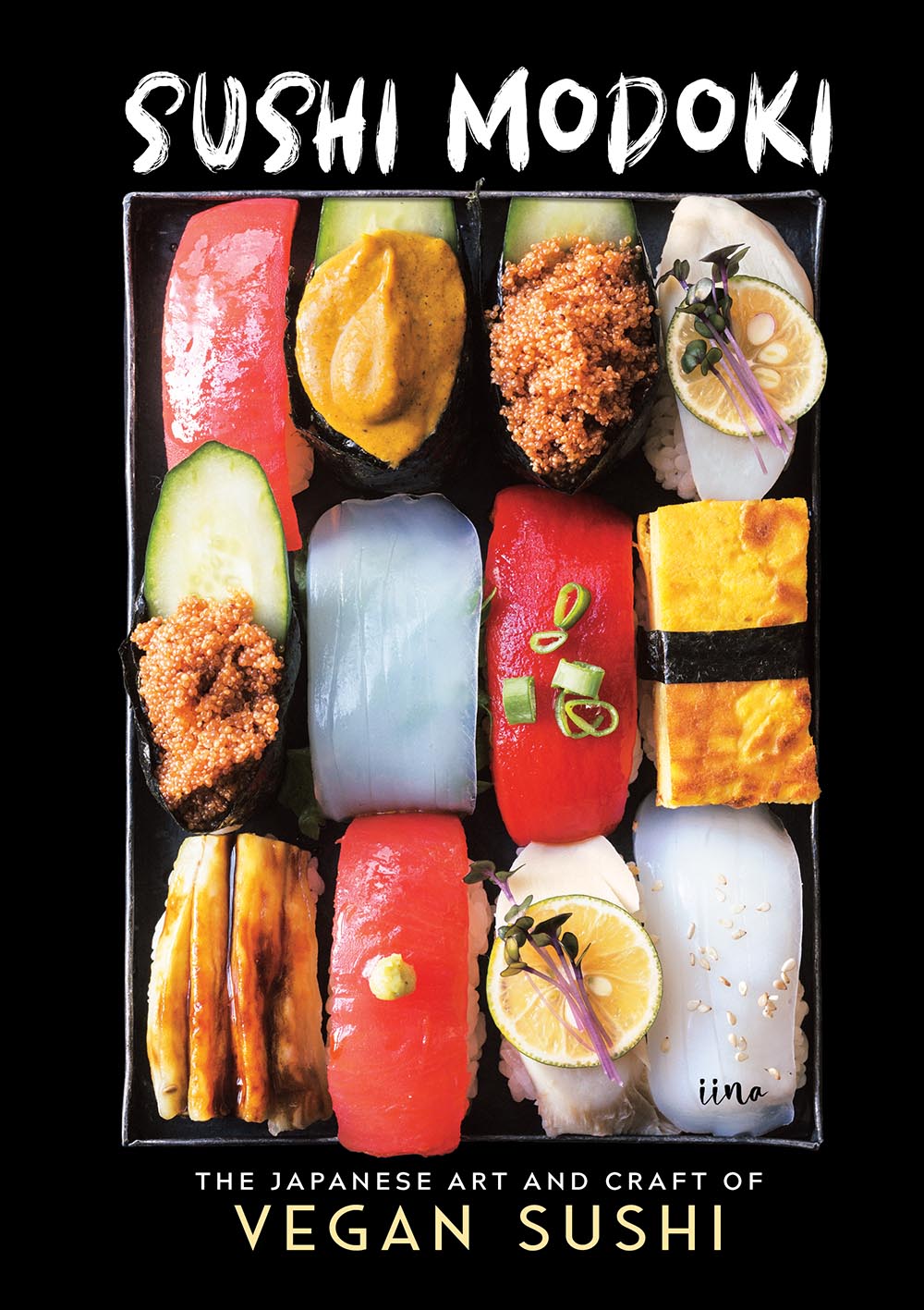Recipe for Vegan Sushi by Chef iina
You could be forgiven for thinking this was salmon sushi when the fish is in fact replaced with carrot.

© Sushi Modoki
In this recipe for ‘salmon’ sushi nigiri, in which subtly seasoned carrot is used as a substitute for fish, iina proves that there’s no dish that can’t be made as a vegan version. The chef also shares her homemade accompaniments, while making sure to use as few processed products as possible.
Salmon, tuna, or even scallop sushi… Chef iina’s recipes are mouth-watering. But after taking a look at the list of ingredients used to make the 50 recipes in her book Sushi Modoki, it becomes clear that there’s no sign of fish to be found. Here, tuna is replaced with tomato, while salmon is replaced with carrot. It’s a game of trickery already hinted at in the title of her book, as the Japanese word modoki translates as ‘imitation.’
Makes 10 pieces
Ingredients
Salmon modoki:
½ medium carrot
1 tablespoon flaxseed oil
Nigiri:
150 g basic sushi rice
Wasabi
Thinly sliced onion
Tofu mayonnaise
Basic sushi rice:
Makes 600 g
300 g uncooked sushi-grade white rice
1 square piece of dried kombu (3 cm)
3 tablespoons sushi vinegar (see below)
Sushi vinegar:
Makes about 275 ml, enough for six batches of basic sushi rice
180 ml apple cider vinegar
95 ml light maple syrup
2 tablespoons salt
Combine all of the ingredients in a small bowl. Mix well until the salt dissolves. You can also combine all the ingredients in a small jar with a lid and shake well, also until the salt dissolves.
Tofu mayonnaise:
Makes 450 to 500 g
1 pack (396 g) silken tofu
120 ml canola oil
2 tablespoons apple cider vinegar
1 teaspoon Dijon mustard
1 teaspoon salt
Method
For the salmon modoki:
Use a mandoline to slice the carrot into ten paper-thin slices (see Tips below).
Use a vegetable steamer to steam the carrot slices for about one minute, until fork tender (see Tips below). Spread them on a baking sheet.
Pour the oil over the carrot slices and cover tightly with plastic wrap so that it touches the carrots. Let stand for about 15 minutes.
Transfer a few slices to an oven-safe dish and sear with a kitchen torch.
Assemble the nigirizushi (see below) with the rice, using either seared or unseared carrot slices as the topping.
On the unseared salmon modoki, add the wasabi, onion slices, and tofu mayonnaise as desired.
TIPS:
Using a mandoline to slice the carrots will create the perfect curve for nigirizushi.
Do not overcook the carrot slices—they will easily fall apart.
For the nigirizushi:
Prepare vinegar water (equal parts water and rice vinegar) in a small bowl. Wet your hands by dipping them in the vinegar water.
Place one of the toppings in the palm of your left hand. Use your right index finger to add a thin layer of wasabi to the topping.
Use your right hand to grab about 1 heaped tablespoon (15 g) of the sushi rice. Softly ball the rice in your palm and place it on the topping. Press down with your left thumb to make a dent in the centre of the ball.
Adjust the shape of the rice with your right thumb and index finger.
Flip the nigirizushi over so the topping is facing up. Adjust the shape using your right index and middle fingers.
To cook the rice:
Rice cooker method:
Gently wash the rice in water to remove any rice bran or impurities. Rinse several times, until the water is no longer cloudy.
Transfer the washed rice to the inner pot of a rice cooker. Add 360 ml water and the kombu; if your rice cooker has a water level indicator for cooking rice for sushi, add water to that line. Set aside to soak for 30 minutes to 1 hour.
Insert the inner pot into the rice cooker and turn it on.
When the rice is cooked, keep the cooker closed and leave for ten to 15 minutes to steam.
Transfer the rice to a bowl. Fold the sushi vinegar into the rice using a wooden rice paddle. While folding, cool the rice using a fan to remove moisture (this will prevent it from becoming overly starchy).
Once the rice has become shiny and cooled to room temperature, cover the bowl with a dampened kitchen towel or paper towel to prevent the rice from drying out. Set aside until you are ready to make the sushi, for no longer than a few hours.
Stove-top method:
Put the rice in a bowl with water and wash gently. Rinse the rice several times, until the water is no longer cloudy, and transfer to a medium saucepan. Add 360 ml water and the kombu. Let soak for 30 minutes.
Cover the pot and bring to a boil. Reduce the heat to low and simmer for about five minutes. Remove from the heat.
Let stand for 15 minutes while covered.
Remove the lid and gently fluff the rice with a spoon or spatula.
Sushi Modoki (2019), a recipe book by iina, is published by The Experiment.
Chef iina graduated from L’ecole Vantan Culinary School in Tokyo, then settled at Brown’s Field, an organic farm in the south of Chiba Prefecture, where she learnt to grow and preserve organic fruit and vegetables. She then became the chef at Rice Terrace Café, before moving to Tokyo and beginning her career as a vegan chef.
Sushi Modoki is iina’s first book. It also contains detailed ideas for salads, soups, and drinks alongside the sushi recipes.

© Shinsaku Kato

© Sushi Modoki
TRENDING
-
A House from the Taisho Era Reveals Its Secrets
While visiting an abandoned building, Hamish Campbell discovered photographs the owner had taken of the place in the 1920s.

-
The Taboo-Breaking Erotica of Toshio Saeki
The master of the 1970s Japanese avant-garde reimagined his most iconic artworks for a limited box set with silkscreen artist Fumie Taniyama.

-
With Meisa Fujishiro, Tokyo's Nudes Stand Tall
In the series 'Sketches of Tokyo', the photographer revisits the genre by bringing it face to face with the capital's architecture.

-
Masahisa Fukase's Family Portraits
In his series ‘Family’, the photographer compiles surprising photos in which he questions death, the inescapable.

-
Hajime Sorayama's Futuristic Eroticism
The illustrator is the pioneer for a form of hyperrealism that combines sensuality and technology and depicts sexualised robots.





